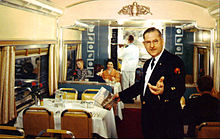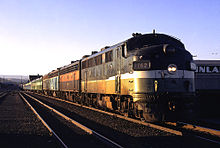North Coast Limited
The North Coast Limited was a luxury train operated by the Northern Pacific Railway . The train was introduced as early as 1900 and was in service until 1971, making it one of the longest-lived name plates in the USA. He was particularly known for his dining car operation, which was among the best of its kind in the United States.
route
The route of the train led from Chicago via the "Twin Cities" St. Paul / Minneapolis , Fargo and Spokane to Tacoma and Seattle . The train crossed some of the most beautiful American landscapes, starting with the Great Lakes near Chicago, then over the fertile farming country of Wisconsin , then over the endless prairies of North Dakota and Montana and finally through the Rocky Mountains of Montana, Idaho and Washington . The train passed through eight mountain ranges of the Rocky Mountains, and its journey times were set so that the most scenic areas (the Rocky Mountains) were crossed during the day. There was even a direct connecting train for passengers who wanted to get into Yellowstone National Park . In Pasco , a train section was separated from 1909 and led to Portland (Oregon) via the Spokane, Portland and Seattle Railway . The operation from Chicago to the Twin Cities was not carried out by the Northern Pacific, but by the Chicago, Burlington and Quincy Railroad via their route along the Mississippi River .
commitment
From the beginning, the train was a luxury train that offered top-class service. There were dining cars, sleeping cars with different compartments, snack-bar lounge cars, and even cars with a built-in library and smoking lounge and solarium. Even showers and manicure services for women were offered at record times. Later combined observation seating cars and observation sleeping cars were added, and a kind of “stewardesses” specially trained for the luxury trains took care of the passengers. The train was the flagship of the Northern Pacific throughout its existence and was in strong competition with the luxury trains of its rivals, the " Empire Builder " of the Great Northern Railway and the " Olympian Hiawatha " of Milwaukee Road .
The train experienced its heyday from 1900 to 1929 and then again from 1948 to 1967. Until 1929 it was even an “all-sleeper” train, which means that it consisted exclusively of 1st class sleeping cars. Until 1948 the train consisted of heavy, six-axle wagons that were painted olive green and were made of wood until around 1912 and steel after 1912. The train was modernized between 1945 and 1948 and consisted of four-axle streamlined cars until the end of 1971. Air conditioning was introduced as early as 1933 and from 1948 the train was no longer pulled by steam locomotives, but by multi-part diesel locomotives. From 1948 to 1953 the cars were painted as follows: light gray roof, olive green band above the windows with yellow “Northern Pacific” lettering, light green window band and olive green band below the window. The individual bands were separated by yellow decorative lines. In 1954 the color scheme changed. From then on, the roof, the ribbon above the windows and the ribbon of windows were dark mint green. There was a white decorative line directly below the ribbon of windows, and the ribbon below the window was light green, and there was also the lettering "The Vista Dome North Coast Limited" with a white, black and red Northern Pacific logo. "Northern Pacific" was also emblazoned above the window in white. The train's diesel locomotives were also painted this way.

From 1954 onwards, every North Coast Limited included four observation cars on the train, including two observation seating cars (for 2nd class seated passengers) and two observation sleeping cars (for 1st class sleeping car passengers). Thus, 96 passengers had a viewing car seat available in the entire train (24 per viewing platform). In 1955 the "Louis & Clark Traveller's Rest Tavern" was introduced, a snack bar lounge car for light meals, which was clad with wood on the inside and was completely decorated in the Wild West scheme. The sleeping car passengers had the exclusive use of the end car with its rounded end as a saloon car with a cocktail bar. When this car was abolished in 1967, the observation sleeping cars were converted into observation sleeping bar cars by replacing the sleeping compartments under the viewing pulpits with bars; the cars were also called “Lounge in the Sky” because some of the seats in the viewing platform were replaced by tables.
Train composition
Train composition from 1937:
Steam locomotive Alco Z-6 4-6-6-4 with 16 cars: 1st mail car; 2. Baggage sleeping car (for train crew); 3. seating car; 4. seating car; 5. tourist sleeping car; 6. tourist sleeping car; 7. dining car; 8. Rice Lake sleeper car; 9. "Kamiakin" sleeping car; 10. “Black Foot” sleeping car; 11. Sleeping car “Many Horns”; 12. “Standing Buffalo” sleeping car; 13. “Gap” sleeping car; 14. "Glade" sleeping car; 15. Sleeping car with buffet solarium "Canyon"; 16. Lounge end car.
Train composition from 1956:
Diesel locomotive EMD FP7 ABBBA Unit with 17 cars: 1. Baggage car; 2. Post sleeping car (for train crew); 3. Viewing seating car; 4. seating car; 5. seating car; 6. seating car; 7. Viewing seating car; 8. seating car; 9. “Traveller's Rest Tavern” snack bar lounge car; 10. dining car; 11. Viewing sleeper car; 12. sleeping car; 13. sleeping car; 14th sleeping car, 15th observation sleeping car; 16th sleeping car, 17th saloon-bar-end car.
attitude
Although the Northern Pacific, unlike many other railway companies, did very well in the passenger business in the late 1950s and 1960s and the North Coast Limited was always a well-stocked train, the number of passengers dwindled so drastically in the late 1960s that even the top service, the luxury and the good reputation of the train didn't help anymore, the train got shorter and shorter and more and more services had to be restricted. From 1968 the train between Chicago and St. Paul / Minneapolis and between Spokane and Seattle / Portland was even combined with its ex-rival, the “Empire Builder” of the Great Northern.
In 1970, the Northern Pacific, Great Northern, Chicago, Burlington and Quincy Railroad and Spokane, Portland and Seattle Railway merged to form the new Burlington Northern Railroad , under which the train continued for 1 year until May 1, 1971, and then with the establishment of Amtrak has been discontinued. Thus ended an era of travel on the Northern Pacific, and one of the best passenger trains in the United States went down in history.
On June 5, 1971, Amtrak introduced the North Coast Hiawatha , a name-creating mixture of the North Coast Limited and the Olympian Hiawatha of Milwaukee Road, mainly on the former route of the North Coast Limited . The train was merged between Chicago and Minneapolis and between Spokane and Seattle with the Empire Builder , who drove on the latter section at that time on the former route of the North Coast Limited via Yakima . He ran three times a week. From November 14, 1971, the North Coast Hiawatha was operated between Chicago and Spokane as an independent train and between Chicago and Minneapolis even daily along the former Milwaukee Road route. Between Spokane and Seattle, it continued to be affiliated with the Empire Builder. From June 11, 1973, the train was run on the entire route from Chicago to Seattle as an independent train. He continued to run three times a week except in summer and during the holiday season. The Empire Builder route over the Cascade Tunnel was now used between Spokane and Seattle . On October 1, 1979, the train route was canceled.
A large part of the original route is no longer used by passenger traffic. Amtrak's Empire Builder now only operates between St. Paul and Moorhead and between Sandpoint and Pasco on the route. It operates as the only remaining train route from Chicago to the Pacific Northwest instead continues on the former main route of the Great Northern over the Marias Pass .
literature
- William R. Kuebler, Jr .: The Vista-Dome North Coast Limited: The Story of the Northern Pacific Railway's Famous Domeliner . Oso Publishing Company, 2003, ISBN 1-931064-06-7 .
- William A. McKenzie: Dining Car to the Pacific: The "Famously Good" Food of the Northern Pacific Railway . University of Minnesota Press, 2004, ISBN 0-8166-4562-0 .


